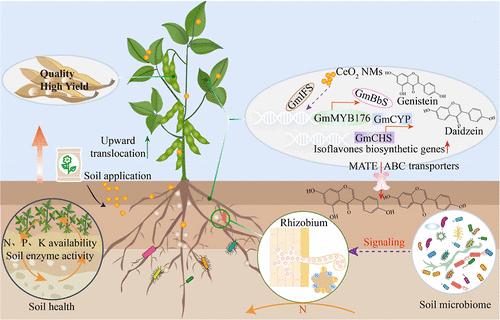Deciphering the Dynamic Interplay between Rhizobacteria and Root Exudates via Cerium Oxide Nanomaterials Modulation for Promoting Soybean Yield and Quality
IF 6.2
1区 农林科学
Q1 AGRICULTURE, MULTIDISCIPLINARY
引用次数: 0
Abstract
The interplay between root exudates and rhizobacteria is essential for enhancing agricultural productivity. Herein, the impacts of cerium dioxide nanomaterials (CeO2 NMs) on these interactions in soybean plants were investigated. Following 3–5 weeks of exposure to 5 mg·kg–1 CeO2 NMs, the composition of root exudates changed over time, with isoflavone levels increasing by 6.3–21.7 folds, potentially manipulating the rhizobacteria. Correspondingly, rhizobacteria such as Ensifer, Allorhizobium, Nitrospira, and Bradyrhizobium were enriched by 40.7–367.3% at three time points. CeO2 NMs stimulated isoflavone biosynthesis in soybean plants and their excretion into the rhizosphere via upregulating the expressions of MYB transcription factors, biosynthesis, and transporter genes. The interactions of root exudates and rhizobacteria mediated by CeO2 NMs enhanced plant biomass (45.5–75.9%), nodulation (85.7%), nitrogen fixation, nutrient acquisition, and soil health, improving soybean quality (34.4–223.9%) and yield (16.2%). This study provides insights into root exudate-rhizobacteria interactions in leguminous plants facilitated by NMs for sustainable agriculture.

通过氧化铈纳米材料调控解读根瘤菌与根分泌物的动态相互作用,提高大豆产量和品质
根分泌物与根际细菌之间的相互作用对提高农业生产力至关重要。本文研究了二氧化铈纳米材料(CeO2 NMs)对大豆植物中这些相互作用的影响。在暴露于5 mg·kg-1 CeO2 NMs 3-5周后,根分泌物的组成随时间发生变化,异黄酮含量增加6.3-21.7倍,可能对根细菌有影响。相应的,Ensifer、alloorhizobium、Nitrospira和Bradyrhizobium等根瘤菌在三个时间点上的富集量为40.7-367.3%。CeO2 NMs通过上调MYB转录因子、生物合成和转运基因的表达,促进大豆异黄酮的生物合成及其向根际的排泄。CeO2 NMs介导的根分泌物与根际细菌的相互作用提高了植物生物量(45.5-75.9%)、结瘤率(85.7%)、固氮、养分获取和土壤健康,改善了大豆品质(34.4-223.9%)和产量(16.2%)。本研究为豆科植物根系分泌物与根际细菌的相互作用提供了新的认识,为可持续农业提供了NMs的促进作用。
本文章由计算机程序翻译,如有差异,请以英文原文为准。
求助全文
约1分钟内获得全文
求助全文
来源期刊
CiteScore
9.90
自引率
8.20%
发文量
1375
审稿时长
2.3 months
期刊介绍:
The Journal of Agricultural and Food Chemistry publishes high-quality, cutting edge original research representing complete studies and research advances dealing with the chemistry and biochemistry of agriculture and food. The Journal also encourages papers with chemistry and/or biochemistry as a major component combined with biological/sensory/nutritional/toxicological evaluation related to agriculture and/or food.

 求助内容:
求助内容: 应助结果提醒方式:
应助结果提醒方式:


